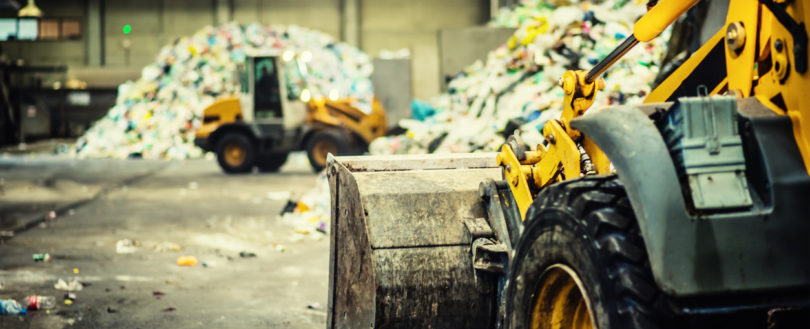- Homepage
- News
- Blogs & Articles
- New FIA research could be the answer to fires in waste recycling centres

New FIA research could be the answer to fires in waste recycling centres
Like it? Share it!
06 February 2017 by FIA Team, FIA Team
It perhaps happens a little more often than we’d like – it seems not a month goes by without switching on the television to find a news story about a fire in a middle of a town because someone’s scrapyard has gone up in flames.
Fires in waste recycling centres are wild, dangerous, and can produce a range of noxious gases. The worst part is that they can be extremely difficult to extinguish – and with cuts to fire services nationwide, the need to protect people and property in the surrounding areas, and prevent these fires from starting is becoming even more pertinent.
The problem is that once a fire starts, they can have a severe impact on the environment. You only have to imagine the kinds of items that are in the average waste pile – a mixture of wood, plastics, scrap metals, paper, old cardboard boxes – to realise that the gases created when these burn is going to be harmful to all aspects of the environment: our air quality, animals, people, the fact that these harmful gases may condense into our water system.

Fires in waste centres can be a huge environmental concern.
As a result, the Environment Agency recently put out a statement saying that there was a need to reduce the amount of time that these fires burn, limiting the time to four hours, i.e. once the fire starts it must be extinguished within a time frame of four hours. However, many waste fires burn for much longer than this due to the sheer size and scale of the fire. WISH (the Waste Industry Safety & Health forum, who represents those who manage scrapyards and recycling centres) responded to this statement with their own document-come-press release. In it, they argue that four hours burn time is unrealistic; fires burn much longer than that and the target that the Environment Agency has set is unattainable.
The need to reduce the burn time of these fires is becoming more apparent. But how?

Nigel Joslin, Chair of Working Group Foam has been
leading the research
The Fire Industry Association has a number of different Working Groups (WG) who can conduct research into a range of fire related matters. WG Foam decided to take on this matter and find out if there is a faster way to extinguish fires in waste recycling centres. If the research is successful, the conclusions may draw some light on how to best control the fires – reducing the impact on the environment, and helping firefighters and waste recycling owners to extinguish fires quicker.
“Where we’re coming from as a working group is, well, the sort of science and technology behind this sort of fire and how you tackle it is not well understood,” explained Nigel Joslin, Chair of the FIA’s WG Foam. “There’s a need for greater research into – not so much how these fires take place – but into the characteristics of them when they’re burning, and what the best approach is in terms of strategy and tactics for extinguishing them.”
“With funding from the FIA, we’re running our own research project into not so much how these fires start/develop, but from the view of what technology in terms of firefighting chemicals that are available which might aid in putting them out, such as wetting agents. Because normally the fire brigade turns up and just throws a lot of water at it. But perhaps there is a better way of doing this – maybe it would be better if the water was replaced by something like a Class A foam.”
Joslin explains that the project will look at the effectiveness of different foams and wetting agents over plain water, for use in this application. The prediction from the research group is that wetting agents may perform better in certain conditions – but the research aims to narrow down which wetting agent performs best and under what conditions, and most importantly, why.
“You’ve got these two bodies, the Environment Agency on one side and WISH on the other, each basing their statements on their own knowledge and experience. Clearly there’s a divergence there, and it just shows that more needs to be done. It just shows that it’s all in it’s infancy still – we haven’t really got a consensus on what really needs to happen.”
The research is currently being conducted by the FIA’s WG Foam, with the aim for completion of the practical lab tests in around six weeks.
The project is in three phases – the first being a literature survey to look into any previous research from the past 30-40 years that covers lab-scale testing of the effectiveness of wetting agents versus plain water. It is important to see and compare the conclusions that others have previously made, so that the FIA’s research can develop any current ideas and help industry professionals understand the science behind why a wetting agent might be more effective than just water alone.

Lab testing may reveal the answers
“We want to understand at an almost molecular level, why a wetting agent might do better than water. So there’s not just evidence from test work, but scientific theory to underpin why it’s better,” said Joslin. “And we’ll examine all the literature and evidence of the past to help us find that before we do our lab tests.”
The second and third stage of the research is to carry out small-scale lab tests on the different wetting agents and foams, to find out which ones provide the most coverage and which ones saturate materials faster. The likely prediction is that those wetting agents and foams that provide the widest coverage and are quicker to penetrate and saturate a material faster, are more likely to extinguish a fire faster.
This research comes at a very important time, as previous tests carried out on behalf of WISH anecdotally only used water; foams and wetting agents were never considered. Prior tests only looked to discover how certain materials burn and how long it takes for them to be extinguished using water.
“Water can be very effective,” explained the FIA Chair of WG Foam. “But sometimes, it’s totally ineffective […] You can look back over past real life incidents where there’s been fires in recycling centres, and sometimes the sprinkler system has worked wonderfully well, and put the fire out, and sometimes the whole building has been burnt down – even when there’s a sprinkler system. It just hasn’t been able to control the fire. Sometimes fires are just too large; they overwhelm the sprinkler system.”
So there does indeed exist a gap in current knowledge that needs to be fully investigated. The FIA research hopes to bridge this gap by bringing a full report on the effectiveness of wetting agents and foams on fires in recycling centres. If it does in fact turn out that wetting agents are better than water, then of course this would be an improvement, reducing the burn time of fires, and making the time limit of four hours set by the Environment Agency more achievable.
Of course, the benefits of reducing the burn time are not just environmental.
“You might be able to reduce the size, and therefore cost, of your sprinkler system if you’ve got a medium that’s more effective. And if we were to discuss the insurance industry, I’m sure they’d be very interested in a more effective way to put out a fire,” said Joslin.
“There are certainly benefits to taking time to understand how wetting agents might work. And of course we might even find that they’ve got their shortcomings. But we might find as well, that they’ve got ways that they might be improved over and above the ones that are currently available on the market. Because the chances are that the ones currently available have already been formulated for a different application. They probably haven’t been formulated for fires in waste tips – they’ve probably been formulated for things like forestry fires, I would guess, and that just happens to be what’s available.
“If there is a particular wetting agent that works better than the others, then yes, we can go on to develop that further – if we can discover why it works more effectively than the rest. What is it about those chemicals in that particular agent or foam that has a certain efficacy or effectiveness? Once we understand that, then that gives us a lead there to investigate how we might improve that formula to make it still better.”
And that, of course, would be beneficial in so many ways.
To find out the results of the research, or to find out more, watch this space. Or contact Technical Manager Robert Thilthorpe for further details.
TAGS
-

FIA Team
FIA Team
Related posts
-
New fire safety standards: FIA announces BS 5306-8: 2023 updates
08 January 2024
By Robert Thilthorpe, FIA Technical Manager
-
On this day, forgotten disasters: Harrow Court fire
02 February 2023
By Kirsty Lavell, Marketing Manager
-
On this day, forgotten disasters: the Colney Hatch fire
23 January 2023
By Kirsty Lavell, Marketing Manager
